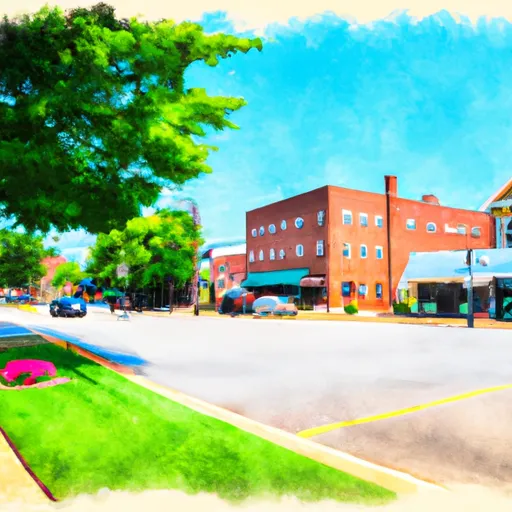-
 Snoflo Premium
Snoflo Premium
Get unlimited access to all our content
With no Ad interruptions! - Start Your Free Trial Login with existing account
Milford
Eden Index
Climate
7.7
•
Recreation
5.1
•
Community
0.9
•
Safeguard
5.1/10

Milford, Indiana is a charming town located in Kosciusko County. It experiences a humid continental climate, characterized by hot and humid summers, and cold winters with moderate snowfall. Summers see temperatures ranging from the mid-70s to low 90s°F, while winters can dip as low as the 20s°F.
Hydrologically, Milford sits on the banks of the picturesque Little Elkhart River. This river, along with several nearby lakes and ponds, offers great opportunities for water-based activities such as fishing, boating, and kayaking. Fishing enthusiasts can expect to catch a variety of fish species, including bass, catfish, and crappie.
Apart from water-based activities, Milford boasts numerous outdoor recreation opportunities. The nearby Waubee Lake Park provides facilities for camping, hiking, and picnicking, offering a serene environment for nature lovers. Milford also connects to the scenic Maple Heart Hiking Trail, which meanders through forests and offers breathtaking views of the surrounding landscape.
Overall, Milford, Indiana offers a pleasant climate, abundant water resources, and a range of outdoor recreation options, making it an attractive destination for nature enthusiasts and outdoor adventurers.
What is the Eden Index?
The Snoflo Eden Index serves as a comprehensive rating system for regions, evaluating their desirability through a holistic assessment of climate health, outdoor recreation opportunities, and natural disaster risk, acknowledging the profound impact of these factors on livability and well-being.
Climate Health Indicator (CHI): 7.7
Milford receives approximately
946mm of rain per year,
with humidity levels near 84%
and air temperatures averaging around
10°C.
Milford has a plant hardyness factor of
5, meaning
plants and agriculture in this region thrive during a short period during spring and early summer. Most
plants will die off during the colder winter months.
By considering the ideal temperature range, reliable water supplies, clean air, and stable seasonal rain or snowpacks, the Climate Health Indicator (CHI) underscores the significance of a healthy climate as the foundation for quality living.
A healthy climate is paramount for ensuring a high quality of life and livability in a region, fostering both physical well-being and environmental harmony. This can be characterized by ideal temperatures, reliable access to water supplies, clean air, and consistent seasonal rain or snowpacks.
Weather Forecast
Streamflow Conditions
Southeastern Lake Michigan
Area Rivers
Southeastern Lake Michigan
Snowpack Depths
Southeastern Lake Michigan
Reservoir Storage Capacity
Southeastern Lake Michigan
Groundwater Levels
Recreational Opportunity Index (ROI): 5.1
The Recreational Opportunity Index (ROI) recognizes the value of outdoor recreational options, such as parks, hiking trails, camping sites, and fishing spots, while acknowledging that climate plays a pivotal role in ensuring the comfort and consistency of these experiences.
Access to outdoor recreational opportunities, encompassing activities such as parks, hiking, camping, and fishing, is crucial for overall well-being, and the climate plays a pivotal role in enabling and enhancing these experiences, ensuring that individuals can engage in nature-based activities comfortably and consistently.
Camping Areas
| Campground | Campsites | Reservations | Toilets | Showers | Elevation |
|---|---|---|---|---|---|
| Delaney Creek Park | None | 584 ft | |||
| Camp Atterbury Military | None | 715 ft | |||
| Clark State Forest | 45 | 851 ft | |||
| Irwin City Park | 12 | 662 ft | |||
| Johnson County Park | 50 | 741 ft | |||
| Deam Lake State Rec Area | 185 | 533 ft | |||
| Heflen Co Park | None | 639 ft | |||
| Starve Hollow State Rec Area | 200 | 552 ft | |||
| Jackson - Washington State Forest | None | 672 ft | |||
| Hardy Lake State Rec Area | 170 | 650 ft |
Nearby Ski Areas
Catastrophe Safeguard Index (CSI):
The Catastrophe Safeguard Index (CSI) recognizes that natural disaster risk, encompassing floods, fires, hurricanes, and tornadoes, can drastically affect safety and the overall appeal of an area.
The level of natural disaster risk in a region significantly affects safety and the overall livability, with climate change amplifying these risks by potentially increasing the frequency and intensity of events like floods, fires, hurricanes, and tornadoes, thereby posing substantial challenges to community resilience and well-being.
Community Resilience Indicator (CRI): 0.9
The Community Resilience Indicator (CRI) recognizes that education, healthcare, and socioeconomics are crucial to the well-being of a region. The CRI acknowledges the profound impact of these elements on residents' overall quality of life. By evaluating educational resources, healthcare accessibility, and economic inclusivity, the index captures the essential aspects that contribute to a thriving community, fostering resident satisfaction, equity, and social cohesion.

